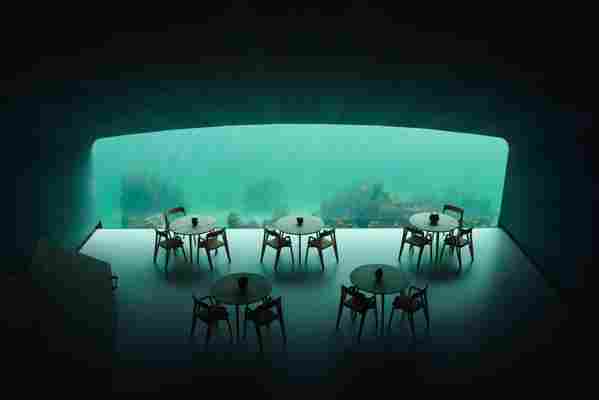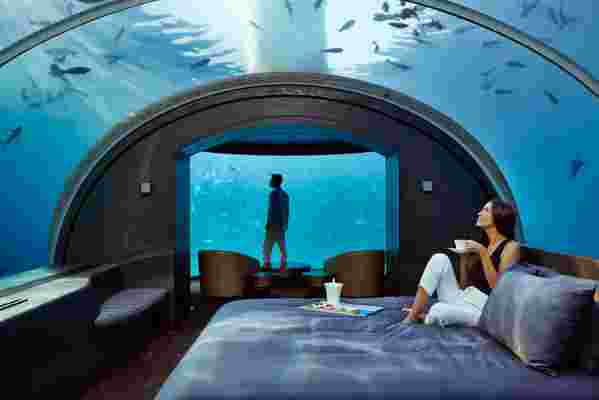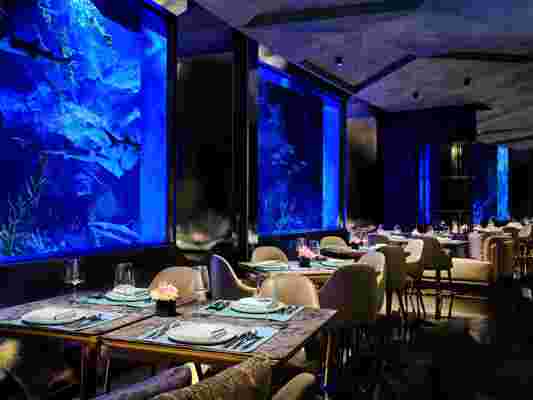For a long time, architectural innovation has primarily been about attempting to reach new heights with towering skyscrapers and mega-developments. But recently, several projects have tried to plumb the depths, trading views of the city for those of marine life. So what has taken architects out of the clouds and under the sea? For starters, there’s a wow-factor that comes with a subaquatic space, offering an opportunity to see a part of the word rarely seen without a wetsuit or submersible.
Several underwater attractions have been built in the Maldives and Fiji, taking the region’s overwater villas to the next level and giving guests the chance to be surrounded by the crystal-clear water and tropical fish. Conrad Maldives Rangali Island is home to Ithaa, the world’s first underwater restaurant, and the Muraka, a suite with a submerged lower level. In China, InterContinental Shanghai Wonderland hotel is set in an abandoned quarry, with part of it built into the ground, reaching nearly 290 feet down into a lake. Aquarium walls were installed underwater to heighten the experience.

Inside the Snøhetta-designed restaurant, located off the coast of Norway.
But underwater design can be more than just a tourist attraction. For Under, a restaurant off the coast of Lindesnes, Norway, architectural firm Snøhetta was tasked with creating a structure that would serve multiple purposes. “The initial idea of designing an underwater restaurant at Norway’s southern tip came from our client, brothers Stig and Gaute Ubostad,” says architect and project manager Rune Grasdal. “We had never before designed anything of this kind but found the idea very intriguing, particularly because the structure not only was going to be used as a restaurant but also would play an important role as a marine research center.”

A view of the Muraka, a hotel that’s submerged under water.
The firm devised a nearly 112-foot-long form with a 40-person dining room that sits on the seabed. A 36-foot-wide window gives guests a water view, which varies based on the season and time of day. The structure was designed to become a part of its environment with a concrete façade that will function as an artificial reef. Measurement tools and cameras were installed on and outside the exterior and will provide data to visiting researchers.

In China, InterContinental Shanghai Wonderland hotel is set in an abandoned quarry, with parts of it built into the ground, reaching nearly 290 feet down into a lake.
Though Snøhetta has designed in a variety of challenging locations before, the sea offered a new level of difficulty. “The greatest challenge was submerging the structure into the ocean,” says Grasdal. “During submersion the structure floated on its own and was delicately moved to its final location by a separate crane and tugboats. This was the riskiest phase, but thankfully it went well.” The team had to fill the structure with water to make it sink down to the seabed 16 feel below. Once Under had been anchored to the bedrock, the water was drained, and the team went to work on the interior, which mixes Norwegian oak and nature-inspired hues.
The Conrad Maldives’s Ithaa restaurant allows patrons the extraordinary opportunity to dine under marine life in its natural habitat.
But the firm does not plan on abandoning land anytime soon. “We do not have any immediate plans of [designing other submerged buildings], but this project sure has given us a lot of insight into the construction of underwater structures,” says Grasdal. The firm’s learnings will no doubt be useful to other designers looking to take the plunge into underwater design. Under signals a new possibility for underwater design, one that serves a larger ecological purpose. As cities grow more crowded, subaquatic design offers a new frontier for developers and architects to explore.

Leave a Reply